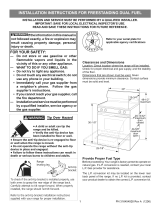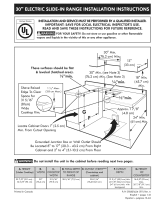
11
INSTRUCCIONES DE INSTALACION PARA LA ESTUFA ELECTRICA DE 30”
2. Herramientas que va a
necesitar
3. Instrucción para la instalación
de las jaciones de anti-inclinación
Para reducir el riesgo de inclinación de la
cocina, ésta debe ser asegurada hacia el piso con las jaciones
de anti-inclinación y los tornillos que vienen con la cocina. Si
no instala las jaciones, corre el riesgo que su cocina pueda
inclinarse si pone demasiado peso sobre la puerta abierta o si
un niño sube sobre ésta. Esto podría ocasionar graves lesiones
causadas por derrames de líquidos calientes o por la propria
cocina.
Si la cocina es trasladada a otro lugar, las jaciones de anti-
inclinación deben también ser trasladadas y instaladas con la
cocina.
Las instrucciones provistas sirven para instalación en suelo de
madera o concreto. Al jar los tornillos al suelo, asegurase que
no atraviesen la instalación eléctrica o de fontanería.
A. Ubicación del soporte utilizando la plantilla - (El
soporte puede ser ubicado ya sea en el lado izquierdo
o derecho de la estufa. Use la información indicada a
continuación para colocar el soporte si no se dispone de
la plantilla). Marque el piso o la pared donde se colocará
el costado izquierdo o derecho de la estufa. Si la parte
trasera de la estufa será colocada contra la pared o a no
más de 1-13/16" (46 mm) de la pared cuando ya esté
instalada, usted puede usar el método de instalación
en el piso o en la pared. Si tiene moldura instalada
y ésta no permite que el soporte quede a ras contra
la pared, retire la moldura o instale el soporte en el
piso. Para el montaje en la pared, ubique la plantilla
colocando el borde trasero de la plantilla contra la
pared trasera y el borde lateral de la plantilla en
la marca hecha indicando el costado de la estufa.
Coloque el soporte sobre la plantilla y marque la
ubicación de los agujeros de los tornillos en la pared.
Si la parte trasera de la estufa está a más de 1-13/16”
(46 mm) de la pared cuando ya está instalada, instale el
soporte en el piso. Para el montaje en el piso, ubique el
soporte colocando el borde trasero de la plantilla donde
quedará ubicada la parte trasera de la estufa. Marque la
ubicación de los agujeros de los tornillos mostrados en la
plantilla.
B. Taladre agujeros pilotos e instale el soporte - Taladre
un agujero piloto de 1/8” donde se vayan a instalar los
tornillos. Si el soporte va a ser instalado en la pared,
taladre un agujero piloto en un ángulo descente de
aproximadamente 20°. Si el soporte va a ser instalado en
pisos de mampostería o de cerámica, taladre un agujero
piloto de 5/32” y 1-3/4” (44 mm) de profundidad. Los
tornillos provistos pueden ser usados en materiales de
madera o concreto. Use una llave de tuerca de 5/16” (8
mm) o un destornillador de punta plana para asegurar el
soporte en su lugar.
Fig. 4
Fig. 5
Fig. 6
Para patas de nivelación y montura anti-
vuelco
• Llave ajustable o alicates
• Llave para apretar tuercas de 5/16” o
un destornillador de cabeza plana
• Taladro eléctrico y una broca de 1/8”
(broca de taladro de hormigón de
5/32” si se instala sobre hormigón)
• Nivel & Cinta de medición
Para la conexión del suministro eléctrico:
• Llave de boca tubular o llave para
tuercas de 1/4” y 3/8”
Materiales adicionales necesarios
• Cordón eléctrico o Alambre eléctrico
de cobre y conducto metálico (para
alambrado permanente)
Soporte antivuelco
Montaje en la pared
Placa mural
Montaje en el piso
Parte trasera de la estufa
ASEGURE EL SOPORTE
(montaje en la pared o en el piso)
Pata Niveladora
(45.6 mm)
1-13/16” Max.
Pared
Pata Niveladora
Parte trasera de la estufa
(montaje en el piso solomente)
Montaje en el piso Soporte antivuelco
(45.6 mm)
Más de 1-13/16”





















